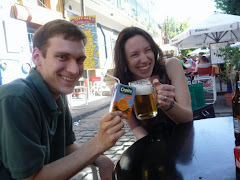One of the biggest benefits (and, at times, one of the biggest downsides) of living here has been the shocking impact of seasons. While we may hear in America that it's better to buy foods in season or that fruits and vegetables taste better (and are cheaper) in season, I know that back at home I wasn't always in tune with what produce had its season when. Our reality of raspberries in January, apples in March and squash in June means that we don't really always see what foods are supposed to be in season at a particular time.
Here, we don't have the luxury of picking up a carton of strawberries imported from Chile in mid-winter. We get strawberries for a handful of weeks in May-June. They are absolutely delicious then, but blink and you miss the season. And, nice as it is to eat in season, I do miss eating fresh (or even frozen) berries whenever I want them.
Drying apples and pears
But nature rolls on and seasons dictate most of what we eat here. (There are some imports and greenhouse-grown foods, so we can get tomatoes year-round, but most people agree that these aren't as yummy as fresh, in-season produce.) We have an interesting rotation of fresh fruits and veggies during the late spring, summer and fall, which is something I hope to be more aware of when we get back home. Late winter and early spring are the "lean season" for fresh produce, though. People have to stock up on "putting up" products to help get through this period.
Right now we're in the heart of apple, plum and pear picking seasons in Akhalkalaki (other parts of Georgia are just winding down the grape harvest and persimmon gathering is starting to get under way as well). Now that all the potatoes have been harvested, people have turned the brunt of their attention to these fall fruits. This means that we've had lots of really delicious crispy fruit in the past two weeks or so, and that canning season is in full swing.
Two of the most common jams made here in Akhalkalaki each fall (as far as we can tell) are an apple-butter-like jam and a plum butter, called pelvar. Pelvar purists will say that it's best not to add sugar to the plums as they cook (since they're already an incredibly sweet plum variety) and because it's better to add a certain kind of sweet, green pear instead. Jams and jellies are often teeth-rotting sweet here, so a "small amount" of sugar is usually added even by those who say they don't add sugar (it wasn't much sugar! Only one kilogram!).
Sam spearheaded the pelvar making in our household this fall, thanks to some miscommunication, his push-over tendencies and pure, unadulterated manipulation. He enjoyed it (mostly), but it is excruciating work. Luckily, we found a slow-cooker recipe for making plum butter that we'll be more likely to try back at home.
Early on in the jam-making
After it got too dark and too cold to continue outside over the fire, Sam finished up inside

Some of the finished product, getting packed up for storing

This year has been a banner harvest for apples and plums and pears, though, so we've seen lots of people doing the back-breaking work of slowly stewing fruit over a fire. Others have been drying fruits in the sun to save for winter (usually, they boil the dried fruits during the "lean season" for fresh produce to make a vitamin-rich compote). All the fruit has added to a generally beautiful fall atmosphere, even if the days and nights are getting a little colder and a little darker than we'd prefer.
Apple butter in its earliest stages, on the stovetop

A small plum called panda, drying in the sun








So I haven't read the post yet, just looked at pics and I have to ask - did you bake a panda cake?
ReplyDeleteHa. Blogger needs a like button. Well played, sir.
ReplyDelete